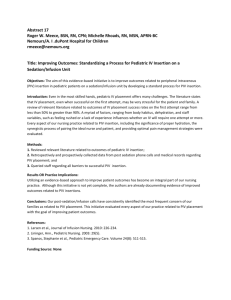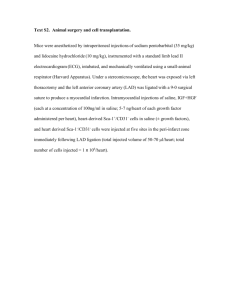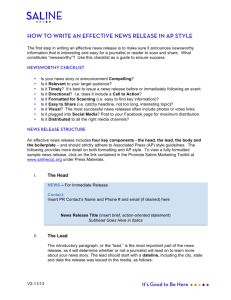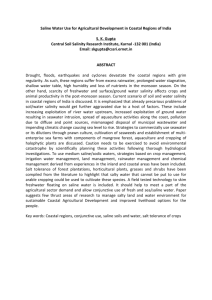title clin_201 pediatric and neonatal peripheral intravenous (piv) line
advertisement
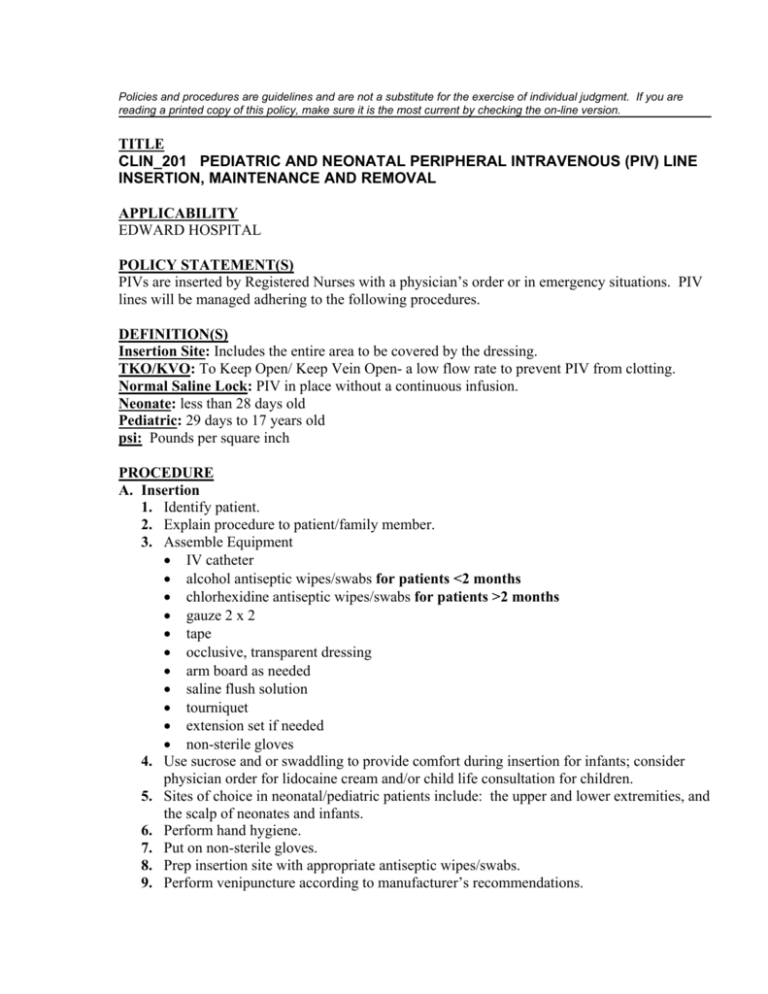
Policies and procedures are guidelines and are not a substitute for the exercise of individual judgment. If you are reading a printed copy of this policy, make sure it is the most current by checking the on-line version. TITLE CLIN_201 PEDIATRIC AND NEONATAL PERIPHERAL INTRAVENOUS (PIV) LINE INSERTION, MAINTENANCE AND REMOVAL APPLICABILITY EDWARD HOSPITAL POLICY STATEMENT(S) PIVs are inserted by Registered Nurses with a physician’s order or in emergency situations. PIV lines will be managed adhering to the following procedures. DEFINITION(S) Insertion Site: Includes the entire area to be covered by the dressing. TKO/KVO: To Keep Open/ Keep Vein Open- a low flow rate to prevent PIV from clotting. Normal Saline Lock: PIV in place without a continuous infusion. Neonate: less than 28 days old Pediatric: 29 days to 17 years old psi: Pounds per square inch PROCEDURE A. Insertion 1. Identify patient. 2. Explain procedure to patient/family member. 3. Assemble Equipment IV catheter alcohol antiseptic wipes/swabs for patients <2 months chlorhexidine antiseptic wipes/swabs for patients >2 months gauze 2 x 2 tape occlusive, transparent dressing arm board as needed saline flush solution tourniquet extension set if needed non-sterile gloves 4. Use sucrose and or swaddling to provide comfort during insertion for infants; consider physician order for lidocaine cream and/or child life consultation for children. 5. Sites of choice in neonatal/pediatric patients include: the upper and lower extremities, and the scalp of neonates and infants. 6. Perform hand hygiene. 7. Put on non-sterile gloves. 8. Prep insertion site with appropriate antiseptic wipes/swabs. 9. Perform venipuncture according to manufacturer’s recommendations. 10. Secure catheter with tape and occlusive, transparent dressing. 11. Discard used supplies and gloves. 12. Perform hand hygiene. 13. Document appropriate actions in Medical Record. B. Infusions 1. Neonates TKO/KVO : less than 5 kg 0.8ml/hr to 1 ml/hr 2. Pediatrics TKO/KVO : greater than 5 kg 3ml/hr to 5 ml/hr 3. Change administration sets, including add on devices and tubing at established intervals depending on type of fluid administration and infusate (as identified in the table below), when contamination is suspected, when integrity is compromised, or with new central line access. Frequency of set change based on administration type Administration Type Administration Set Continuous infusions Primary sets and Secondary “piggy back” sets Intermittent infusions Primary or secondary sets Set Change Frequency 96 hours 24 hours Frequency of set change based on infusate Infusate Type Set Change Frequency Blood and blood products Neonates: after infusion Pediatric: within 4 hours or after 2nd unit, whichever comes first Intravenous fat emulsion Continuous: every 24 hours Parenteral nutrition (TPN) Every 96 hours Propofol Every 12 hours Ativan tubing and filter Every 24 hours Other Continuous Every 96 hours Medication Infusions 4. Label PIV tubing with date and time it was hung and RN initials. Include a 0.2 micron filter with all TPN fluids Include a volume control device (Buretrol) on all tubing for neonatal and pediatric patient’s less than 10 kg Set infusion pump psi as appropriate for patient. C. Site Maintenance 1. Rotate PIV sites on a prn basis. 2. Assess the PIV site for signs and symptoms of infiltration and phlebitis: before and after intermittent infusions every hour during a continuous infusion Pediatric: every 4 hours for saline locks NICU: every 6 hours for saline locks D. Discontinuation 1. RN discontinues PIV as ordered or PRN with a complete site assessment and documentation. 2. Patient Care Technicians (PCTs) in designated units may discontinue PIVs after initial competency and training is completed. E. Saline Lock Registered Nurses may administer normal saline for flushing of saline locks. Saline will be used for all IV locks unless a physician has specifically ordered heparin flushes. NICU: saline locks are flushed every 6 hours and before and after use. Pediatric: saline locks are flushed every 8 hours and before and after use 1. Equipment 3 ml syringe Normal saline solution Alcohol swabs 2. Procedure a. Perform hand hygiene. b. Draw up 1 to 3 ml of normal saline (or heparin flush solution per physician’s order). c. Scrub injection port/needleless connector prior to each access with an alcohol swab for 30 seconds and allow to dry. d. Insert syringe into injection port/needleless connector. e. Inject IV with 1 to 3 ml of normal saline (or heparin flush as ordered by the physician). f. Inspect the site for signs of infiltration. If venipuncture site is infiltrated, discontinue IV and document in medical record. g. Discard used supplies. h. Perform hand hygiene. CROSS REFERENCE(S) CLIN_100, Adult Peripheral Intravenous Line Insertion, Maintenance and Removal Policy No: CLIN_201 Previous Policy No.: CLIN-1017, CLIN-1025, CLIN-100, 6010_020, 6040_010, 6010_025 and 6040_024 03/01/2009 Effective Date: 06/04/2012 Most Recent Review/Revised Date: Policy and Procedure Committee Initiation: Director of Pediatric Services Approval: Policy Committee: 11/13/2008, 04/09/2009; 07/08/2010; 06/09/2011; 08/11/2011; 06/04/2012
